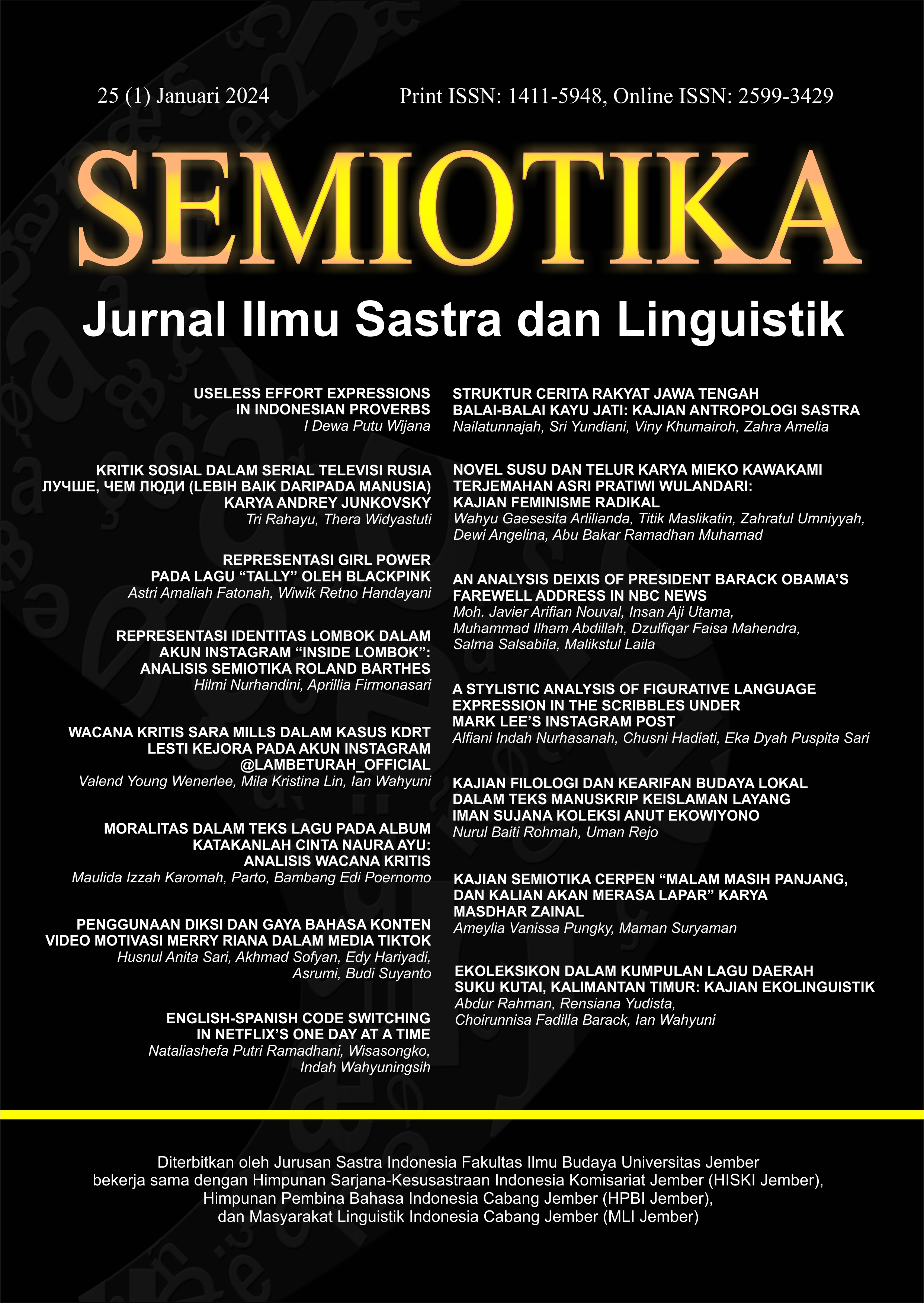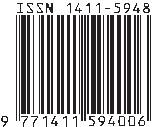NOVEL SUSU DAN TELUR KARYA MIEKO KAWAKAMI TERJEMAHAN ASRI PRATIWI WULANDARI: KAJIAN FEMINISME RADIKAL
Abstract
The topic of feminism in Japan is something that society has not yet fully accepted. This is the reason why researchers chose the novel Susu and Eggs to be used as the object of study. The discrimination that occurs against female characters in the novel leads to extreme actions and thoughts regarding women's freedom regarding their rights. Therefore, the novel Susu and Eggs is studied using radical feminism theory. The aim of this research is to describe the structural analysis and aspects of radical feminism in the object of study. Data discovery was carried out using the library study method, namely reading the novel in its entirety. The description of the data is carried out through qualitative descriptive methods. The research results show that there is a relationship between the title, theme and characterization in the novel. The title relates to the major theme which is supported by the minor theme. The theme is depicted through events that support the characters' characters. On the other hand, the aspects of radical feminism found are divided into five parts, namely: (1) women and their bodies which are related to Midoriko and Natsuko. Midoriko as a teenager who hates the nature of women, then Natsuko as a single woman who cannot find pleasure in sex, but wants to have children through a sperm donor; (2) the inequality of roles in the household which is depicted through the character Yusa Rika who hates her ex-husband; (3) women's beauty standards which include women's body shape and nipple color; (4) stereotypes about women's bodies that discuss women's instincts to get pregnant and societal stigma that prioritizes the penis over the vagina; (5) and sexual violence which includes the act of rape against the character Zen Yuriko.
References
Arivia, G. 2003. Filsafat Berperspektif Feminis. Jakarta: Yayasan Jurnal Perempuan.
Aulia, S. R. 2023. “Analisis Feminisme Radikal Perspektif Kate Millet dalam Novel Susu dan Telur Karya Kawakami Mieko dan Implikasi Keterlibatannya dalam Pembelajaran Sastra di SMK/SMA/MA”. Skripsi. Tulungagung: Program Sarjana Universitas Islam Negeri Sayyid Ali Rahmatullah Tulungagung.
Berlin, S. 2022. “Woman Gives Up Child, Sues Sperm Donor She Met Online for Lying About Education, Ethnicity”. https://www.newsweek.com/woman-gives-child-sues-sperm-donor-she-met-online-lying-about-education-ethnicity-1668550 (Diakses pada 10 Desember 2022)
Caroline, S. A. et al. 2019. “Representasi Perempuan sebagai Simbol Perlawanan pada Novel Jalan Panjang Menuju Pulang Karya Pipiet Senja: Kajian Feminisme Radikal”. Semiotika, 2(20):78—88.
Devi, J. F. V. 2021. “Tabu Menstruasi di Jepang: Saat Darah Haid Dianggap Aib”. https://magdalene.co/story/tabu-menstruasi-di-jepang-saat-darah-haid-dianggap-aib/ (Diakses pada 5 Desember 2023).
Dyama. 2018. “Ngomongin Operasi PLastik, ternyata Jepang Jadi Negara dengan Jumlah Operasi Plastik Terbanyak di Asia”. https://japanesestation.com/entertainment/music/ngomongin-operasi-plastik-ternyata-jepang-jadi-negara-dengan-jumlah-operasi-plastik-tertinggi-di-asia (Diakses pada 13 Desember 2023)
Elmira, P. 2022. “Undang-undang Donasi Sperma di Jepang Picu Kontroversi”. https://www.liputan6.com/lifestyle/read/5105543/undang-undang-donasi-sperma-di-jepang-picu-kontroversi?page=4 (Diakses 10 Desember 2023)
Fatihah, R. & Udasmoro, W. 2023. “Panopticon dan Technologies of the Self pada Tubuh Perempuan dalam Novel Breasts and Eggs Karya Mieko Kawakami”. Tesis. Yogyakarta: Program Pascasarjana Universitas Gadjah Mada.
Fitri, R. A. 2023. “Women’s Dissatisfaction Toward Their Own Bodies in Breasts and Eggs By Mieko Kawakami (2020)”. Tesis. Padang: Program Pascasarjana Universitas Negeri Padang.
Ghaznavi, C. et al. 2023. “Sexual Behaviors among Individuals Aged 20-49 in Japan: Initial Findings from a Quasi-Representative National Survey, 2022”. The Journal of Sex Research. DOI: 10.1080/00224499.2023.2178614.
Kawakami, M. 2021. Susu dan Telur. Terjemahan A.S. Wulandari. Yogyakarta: Taman Moooi Pustaka.
Maslikatin, T. 2007. Kajian Sastra: Prosa, Puisi, Drama. Jember: Fakultas Sastra Universitas Jember.
Moleong, L. J. 2018. Metode Penelitian Kualitatif. Bandung: Remaja Rosdakarya.
Nurgiyantoro, B. 1995. Teori Pengkajian Fiksi. Yogyakarta: Gadjah Mada University Press.
Osumi, M. 2022. “Abortion Legal and Apolitical in Japan, but Cost and Consent Present Barriers”. https://www.japantimes.co.jp/news/2022/06/28/national/social-issues/abortion-japan-rights-explainer/. (Diakses pada 17 Desember 2023)
Prabasmoro, A. P. 2006. Kajian Budaya Feminis: Tubuh, Sastra, dan Budaya Pop. Yogyakarta: Jalasutra.
Puspasari, A. M. 2021. “Citra Perempuan dalam Novel Chichi to Ran Karya Kawakami Mieko: Kritik Sastra Feminisme”. Skripsi. Bandung: Program Sarjana Universitas Komputer Indonesia.
Puspasari, A. M., dan F. Febrianty. 2022. “Karakterisasi Midoriko sebagai Tokoh Pubertas dalam Novel Chichi To Ran karya Kawakami Mieko”. Mahadaya, 2(1):115—128.
Shimizu, Y. 2022. “Is Prostitution Legal in Japan?”. https://www.jluggage.com/blog/lifestyle/is-prostitution-legal-in-japan/. (Diakses pada 17 Desember 2023)
Tarigan, H. G. 2021. Prinsip-Prinsip Dasar Sastra. Edisi Digital. Bandung: Penerbit Angkasa.
Tong, R. P. 2006. Feminist Thought: Pengantar Paling Komprehensif kepada Arus Utama Pemikiran Feminis. Yogyakarta & Bandung: Jalasutra.
Wellek, R. dan Warren, A. 1997. Teori Kesusasteraan. Terjemah Budianta, M. Jakarta: PT Gramedia Pustaka Utama.
Woodman, K. 2023. “Japan Under Pressure: When Social Pressure Becomes too Strong”. https://jobsinjapan.com/living-in-japan-guide/japan-under-pressure-when-social-pressure-becomes-too-strong/. (Diakses 13 Desember 2023)

This work is licensed under a Creative Commons Attribution-ShareAlike 4.0 International License.
SEMIOTIKA has CC-BY-SA or an equivalent license as the optimal license for the publication, distribution, use, and reuse of scholarly work. Authors who publish with this journal retain copyright and grant the journal right of first publication with the work simultaneously licensed under a Creative Commons Attribution-ShareAlike 4.0 International License that allows others to share the work with an acknowledgment of the work's authorship and initial publication in this journal.
Attribution-ShareAlike
CC BY-SA










